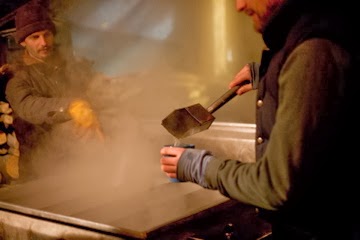 |
| Sugarbush @ Sapsquatch Maple Products |
I started my first year with just 25 trees at the Cayuga Nature Center, where the main focus was education for school and youth groups in the area. My favorite event of the year was MapleFest, which had been going on a the center for more that 40 years during my tenure and attracted hundreds of visitors. Working at this place brought me full circle, as I'd first tapped a tree and tasted sap as a seven-year-old, one of the experiences that began my interest in natural systems at a young age.
From the nature center I joined Josh Dolan at Sapsquatch Maple Products in Enfield, NY, tapping around 500 trees for several seasons and having a go at the "big time" of commercial production. Here we worked hard, slept very little, and pushed everything to its potential. I am glad Sapsquatch is still going strong, through I personally chose to scale back down and for a few years tapped just a few trees in my backyard. With the new farm purchased just last year, we now have our version of perfection; a small, healthy grove of maples that offers about a 100 trees which we tap and boil in the woods, at home.
Entering this season, I took a moment to look through all my past photos and pulled a few to share, along with some anecdotes and stories of my time with sugaring. Here are my three favorite reasons that I come back to sugaring season after season:
1#: The art of sap drinkery
 |
| Examples of enthusiastic "sap faces" from left to right: Sirena Carpenter, Josh Dolan, and Anya Korfine |
One of my favorite aspects of working on all of these operations has been sharing this process with youth, which connects them to the powerful cycles of nature. There is no better way to get a child excited about nature then to show them that sugar can come from a tree! This was my primary experience, and one that I've loved sharing with others, most often for several years as a mentor at EarthArts. Working with kids here earned me one of my favorite nicknames, “Sugarman Steve.”
 | ||
| On a good day, the sap flows like a faucet |
 |
| making a sap + whiskey to fight the chills |
#2: Sugarshack culture
 |
| Good music helps pass the time during a boil |
There is something about a long night spent out in the cold woods yet standing around a warm fire with plenty of hot beverage and the hum of the boiler that feels timeless, offering a chance to slow down and appreciate the world around you. The fact that syrup requires so much attention is a constant reminder that the products of nature come only with patience, precision, and care. Sugaring specifically is a practice that is only found in the northern cold temperate hemisphere on earth, which makes it a unique process married to both time and place.
 | ||
| Emily Meacham stokes the Sapsquatch fire. |
The Maple Sugar Book by Helen and Scott Nearing -- A classic text that provides a great read on the history, lore, and experience of these famous Maine and Vermont homesteaders. The Nearings sugared as the primary means of income generation to support their simple homestead lifestyle.
Backyard Sugarin’ by Rink Mann & Daniel Wolf -- A great read for the basics of small scale sugaring operations. Great examples of homemade sugaring set ups, and many tips for the beginning.
The Sugarmakers Companion By Mike Ferrell -- This book, just out in Fall 2013, is the most up-to-date, comprehensive book on sugaring out there. Just released in 2013, the author (who is director of Cornell’s maple research program, details all the latest research and important steps in sugaring including marketing tips. An absolute must for commercial sugarmakers.
#3: Time in the waking woods
 |
| Dripping spouts are a metronome marking the coming of spring |
While the transition from summer to fall is quite dramatic in these parts, with leaves changing from green to an array of brilliant colors, the signs of winter to spring are more subtle. Walking by buckets and hearing the slow tap-tap-tap of the sap means the trees are moving slow, while on the warmer days the drops fall almost one after the other. Coupling these observations with the larger weather patterns; the wind, the stillness, the sun, the clouds, all tell a unique story and provide a picture show better than any movie or television. The sunsets are often dynamic in purples, blues, and deep reds, while the sunrises offer oranges and yellows which welcome and encourage a weary sugarmaker that another day has arrived, one more day closer to spring.
 |
| On the wall of a sugarshack in Eastern NY |
SEE MORE DETAILS AND SIGN UP HERE.
For more reading on the "how-to" of sugaring, check out this piece Steve wrote for the book he is co-authoring, Farming the Woods.